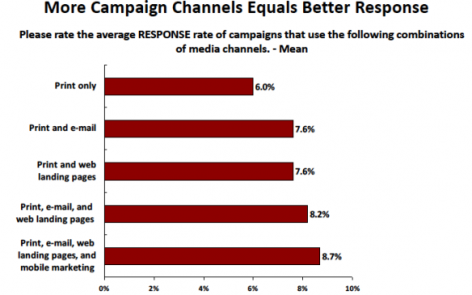It’s not an exaggeration to say the world is going digital. But does that mean direct mail—
long the standard for highly focused, results-driven marketing—is no longer effective and relevant? On the contrary.
In truth, printed direct mail has never been more effective. Not only is it the most targeted of all mediums, but according to a Direct Marketing Association study, [1] it also surpasses email in terms of response rates from existing customers, averaging 3.4% compared to 0.12% for email.
Part of a multichannel marketing approach
Using a variety of devices, channels and contact frequencies is a best practice for lifting consumer response.[2]
Direct mail happens to fit perfectly within a communication stream that includes email, SMS, the web, DRTV and other elements.

A touchstone to the digital world
Research shows that the majority of Internet users conduct online research before making a purchase.[3]
A direct mail piece can play an active role in this process, serving as a launching point to the digital world through personalized URLs to a response microsite, QR 2D barcodes, and even the use of Clickable Paper™ [4] which enhances the brand experience by giving readers access to a variety of rich media.
Enhanced visual impact
Unlike digital ads, served across a variety of screens whose size, resolution and performance may vary widely, direct mail lets the marketer control the creative “canvas” to a larger degree. It allows marketers to create stunning impressions through brilliant high-impact photography, high-density design, plus increased color saturation.
Greater perceived value, longer shelf life
Perhaps because of its potential for great visual impact, printed direct mail may also have a higher perceived value for consumers, increasing the likelihood it will be kept and shared, thus adding to its marketing “shelf life.” It’s ideal for retention and loyalty campaigns.
High levels of personalization
Personalization has been proven to lift response. Fortunately, with technology like variable data printing (VDP), notably Xerox’s XMPie®, direct mail producers can create deep levels of personalization, integrating the recipient’s name and other variables right into artwork and photographs. The results can leave a lasting impression.
With access to the right point-of-sale data and analytics, producers can also entice customers by “building” individualized mail pieces with offers based on their buying preferences, previous purchases and interests.
With or without the variable data enhancement, digital printing is a cost-effective way to send something a little different from your competitors—even in smaller volumes—without blowing your marketing budget.
Direct and digital work hand-in-hand
To paraphrase Mark Twain, reports of direct mail’s death have not only been greatly exaggerated, but misguided. Direct mail not only stands on its own as a highly targeted means of activating consumers on a 1:1 level, it also complements new technologies.
To be sure, direct mail can drive digital interaction—and digital media is now creating innovative new ways for direct mail to be more compelling than ever.
[1] Direct Marketing Association, 2013.
[2] InfoTrends.
[3] Interconnected World: Shopping and Personal Finance, 2012.
[4] A Ricoh technology.






